I read a lot of chatter on the internet that the majority of modern AR-15 models are overgassed to an extreme degree. I’m not a machinist or a gunsmith, so my experience is mostly seat-of-the-pants on the topic. What I can tell you is that I can’t remember the last time I shot a factory AR that refused to lock to the rear on an empty mag or failed to strip a fresh round. What I have had are a lot of guns that force the bolt carrier group and buffer rearward with a great deal of authority, a signal that perhaps more gas is being bled off than is really needed . . .

This problem is only magnified by shooting with a silencer screwed to the muzzle. With the exception of one company that specifically claims to reduce gas blowback with their silencers, most manufacturers acknowledge that screwing a can to the end will increase back pressure. Short term, this is an annoyance as you’ll get hot, dirty gasses delivered straight to your face. Long term, it is hard on the various moving bits of your firearm and one day, someday, maybe, it will lead to premature wear.
Enter the adjustable gas block. Using a machined screw, the amount of gas making its way through the gas system can be regulated down to just what is necessary for reliable function and not a touch more. The advertised benefit is decreased wear, and smoother, flatter shooting rifles. Add in a nice muzzle brake, and you’ll be able to squeeze off triple taps with zero muzzle rise. Take a look at any of the competition rifles at a 3 Gun match, and you’ll see adjustable gas systems all along the line.
When I set out to build an upper for competition, I took a chance on an Odin Works barrel, something I haven’t regretted. As part of the checkout process, their website asked if I wanted to add an adjustable gas block to my order. At $54 for the upgrade ($90 as a standalone), it isn’t a cheap option, but my grandpa always told me, “It only costs a little bit more to fly First Class.”
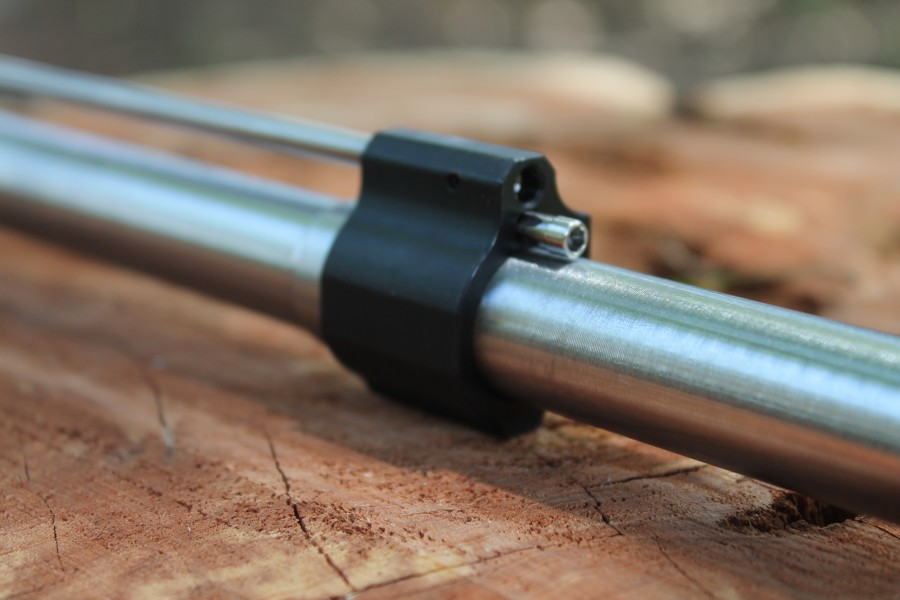
Installation was no more difficult than any other low profile gas block, and I have to commend Odin for making a gas block that fits the same footprint as their regular low profile gas block. It secures to the barrel with two set screw on the lower side. Odin even includes all the wrenches you need for the various screws and adjustments.
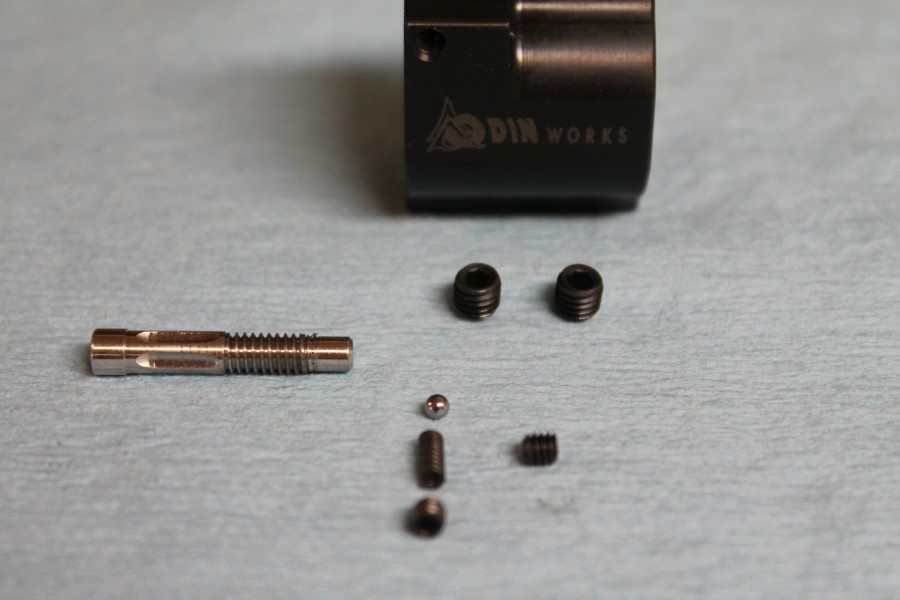
Before I installed the unit, I tore it apart to see how it all worked. I was tickled to find that gas regulator, the long silver piece you see above, has detents machined at set intervals around the perimeter. These work with the set screw and ball bearing detent to ensure that once set, the regulator isn’t going anywhere. You can crank down on the detent screw enough that the regulator won’t turn, a feature I appreciate as someone who has a habit of unintentionally breaking things. All this is backed by another set screw that secures the detent in place. That’s the little threaded piece you see to the right of the ball bearing. Once set, these various screws ensure that your gas position will not be changing unintentionally.
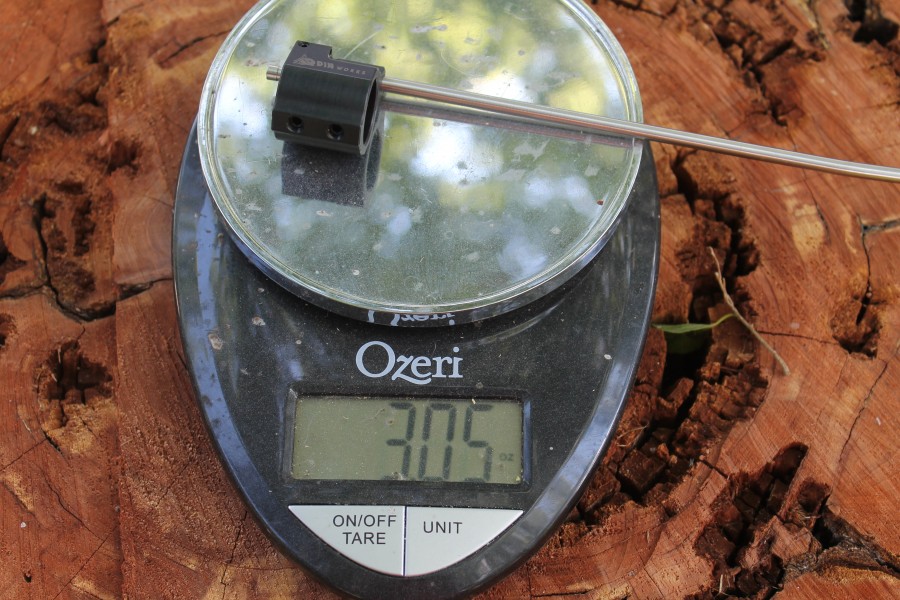
Once installed on the gun, a quick trip to the range, a magazine, and a box of your favorite ammo are all you need to tune it up. Simply start with the gas system at the most open position, load two rounds in your magazine, fire both and ensure the system functions. If it does, screw the detent down one position. Check function again. Repeat this process until the rifle fails to lock back on an empty magazine. Once you’ve reached failure, go back one position and lock it down. The Odin system has twenty positions available, ensuring that you have a broad range of adjustments. Mine ended up being right in the middle with fairly low pressure .223 REM ammo. Odin doesn’t make a distinction on what you should use as your tuning load, but I tuned mine to work with the weakest factory ammo I could find. If you’re setting this up for competition, and you know the load you’ll be using, you can tune it even further. As this is my testing rifle, it needs to function with everything so it is still slightly overgassed with high pressure ammo.
Since installing the gas block nearly eight months ago, I’ve run the better part of five hundred mixed rounds through the rifle without a single failure. This included my trip to Pecos for Run n Gun, an event that looks for weaknesses in gear and exposes them to the world. Between the brake and this gas block, I’ve got a pussycat of a rifle with very little muzzle rise and a very smooth action that still functions with everything I’ve thrown at it.
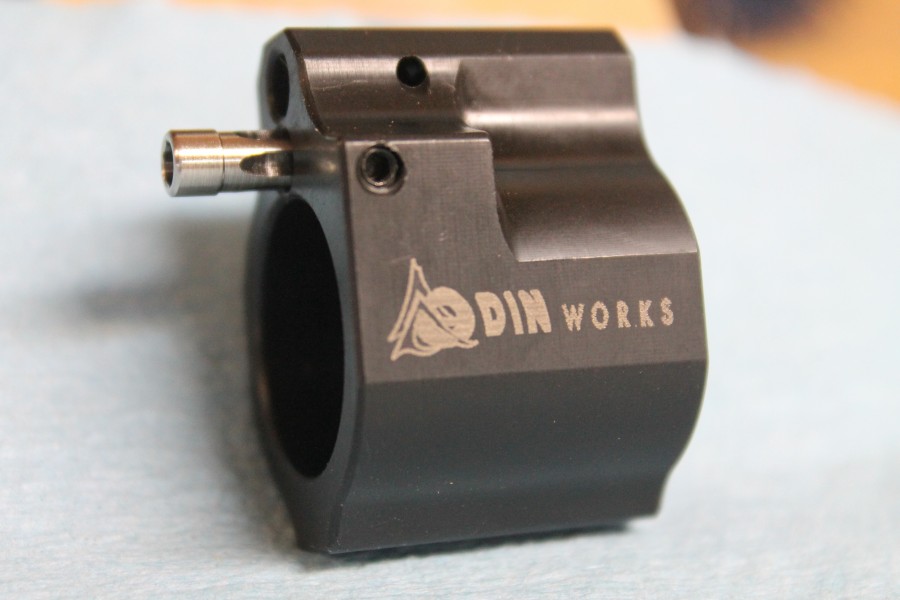
Specifications: Odin Works Adjustable Gas Block
- 20 adjustments
- Fits .750″ diameter barrels
- Inconel adjustment screw and spring
- Weight: 2.15 oz (measured weight with gas tube and roll pin – 3.05 oz)
- Gas block body made from carbon steel
- Includes detent ball, cross pin, set screws, and hex wrenches
- Price: $89.00 ($54 if you’re buying an Odin barrel)
Ratings (out of five stars):
Fit, Finish, Build Quality * * * * *
As I’ve come to expect from Odin, this was a well thought out and well executed piece of gear. At $90, it better be flawless and it is. I had zero issues installing or adjusting it. Many months and several hundred rounds later, it still looks and functions great.
Overall Rating * * * * *
I fully acknowledge that an adjustable gas block is a bit of a luxury purchase. Regular, low profile gas blocks are a dime a dozen and if you’re more interested in reliability over shootability, an overgassed AR is certainly one way to go about getting it. I’ll hold off on objective opinions until Jeremy and I can test this against a regular low profile gas block in his fancy recoil sled, but my seat-of-the-pants impression is that felt recoil is reduced to nothing, and my gas system can be tuned for silencer usage or weak/hot loads. That’s justifies the price.

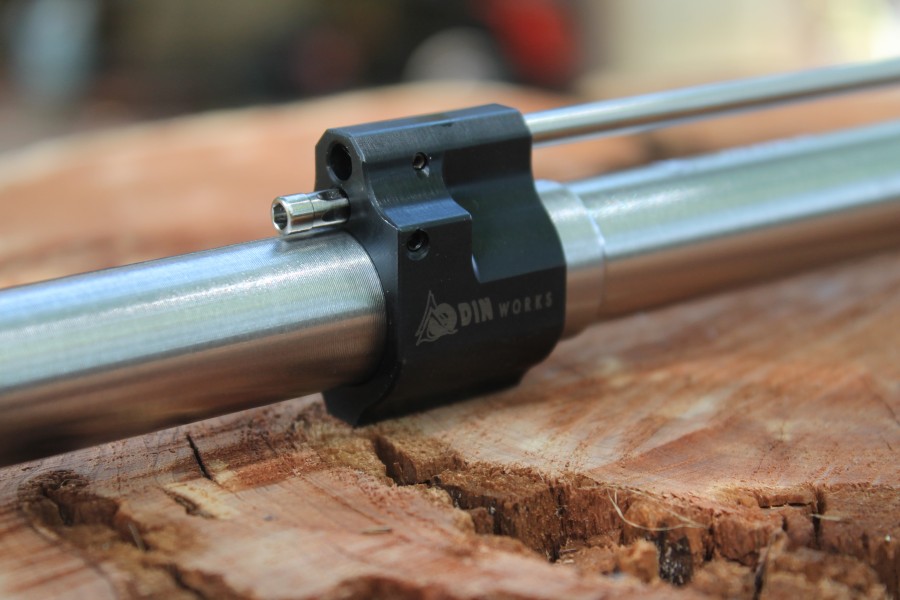



Price: $89.00
Stock Status:(Out of Stock)
Product Code: GB-ADJ
That’s a bit annoying 🙁
http://www.amazon.com/ODIN-Profile-Adjustable-BBRINGTOOL-Assembly/dp/B0195WYDRE/ref=sr_1_sc_2?ie=UTF8&qid=1455856028&sr=8-2-spell&keywords=odinworks+gas+block
Found out last evening that TTAG is ‘blocked’ at Chucky Cheese, of all places.
Always hated that rat…..
What are you doing at the cheesepalace? So far as I know from news here in Florida, people only go there to get into fistfights.
florida man strikes again! he gets all the best headlines too, never fails to amuse or impress.
Florida probably isn’t best gauge of how things are in the rest of the US lol.
Nice. I’ve got odin works parts on my AR 7.62×39 pistol. They are well built and work. I’ve always wondered why more AR builders don’t include these. Ya think it would be GI by now.(like the “old” FNFAL .308)
This fix is a alot easier than tuning an AK action that is for sure. On those you have to tap the gas port, than get some allen caps, drill different size holes in these tiny caps and swap them out until you get the AK to cycle properly.(read not hammering the reciever) I did this to two AK’s and one PSL. Very much improved with out killing the action. But then you are stuck with one type of loading (ammo) if you switch ammo you may have to start over again.
Seekins Precision has one too – mine works quite well, and is a bit less expensive MSRP.
Now change out the bolt carrier to a low mass one, and you can turn it down even lower.
Good review. Well written and nicely done from a technical aspect. However, I could just cry……….Yes the AR is “over-gassed” to a degree. This is to “help” make sure that it will function when it is dirty or in lousy environments. So if you will never use the gun when it is unclean, or in adverse environments, then this device appears to be the bee’s knees for tuning the operation to the ammo. I would never, never, ever have one on my service rifle —- of course, I got in trouble some 45 years ago for continuing to carry a “combat loss” M-14 instead of the AR……and really got beat up by the battalion MSG for letting guys pick up and use AK’s in the field.
Accessories to make your gun work properly.
Something cheapskate AK/Mosin/SKS/Marlin 60/Revolver/Glock owners like me never need to buy.
🙂
I haven’t ever seen one of these that was not lo pro. Do people make a dorito or flip up that has a sight?
When I’m determining the size of the gas port on my AR’s, I look for the empty cases to be ejected to about 4 o’clock, viewed from above. Most of the gas ports in my barrels (none of which are under 16″) will be in the .055 to .065″ region, which is smaller than many of the “spec” gas port diameters, which will almost all be over 0.070, regardless of gas port location.
So yea, the AR, in “mil-spec” form, is getting a bit more gas than necessary. The designers wanted the gun to cycle, period, and it did. The issues started arising when civilian gun owners started creating franken-guns of all manner of barrel lengths and gas system lengths, and then things started needing a way to adjust the gas delivery above and beyond choosing to start small on the gas port hole diameter.
This. The majority of barrels I run across have gaping chasms for gas ports. Way oversized for “reliable” operation with the cheapest combloc .223, I suppose.
Well, I’ve got a 300BLK and my gas port is a whopping .120″ and I STILL had to go with a lighter buffer spring to get it to cycle. This with supersonic ammo out of a 16″ match barrel and…as far as I can tell…a carbine length gas tube. Yeah, I’ve checked everything, well I haven’t checked the hole in the gas block for size. But now that I’ve got the thing to cycle, I can tame it down a touch with one of these adjustable gas blocks. Of course I am open to suggestions.
I’ve got that gas block on a 10.5″ to be used with a suppressor. It was on an ‘intro’ price wherever I picked it up at the time so I thought I’d try it out. Installed without issue and it was nice to adjust for cycling (easy to adjust) and has run without issue.
‘…you’ll get hot, dirty gasses delivered straight to your face.’
I’ve not experienced this using a Gemtech Sandstorm on my Daniels 556 or 308 with factory gas blocks and both carbine and mid-length systems. Seems like most of the gas exits the chamber via the ejection port perhaps?
Hey guys, sorry for being out of stock of this product right now. We’ve had an overwhelming response and we are doing our best to keep up!
We should have them back in stock in about four weeks. We know, four weeks?!?
If you use coupon code TRUEREVIEW10 at checkout you will receive free shipping and a free beanie when you order an adjustable gas block!
Thanks for the review Tyler, and thanks everyone for their comments.
-Alicia
ODIN Works
[email protected]
208-906-1405
The Larue suppressor claims to not increase gas pressure. Is that the manufacturer you are talking about?
I was referencing OSS
I was referencing OSS
If most AR15s are overgassed does that mean that mid-length gas systems are advantageous over carbine length ones with a 16″ barrel?
Basically for the DI, the longer it is, the smoother it will be.
Amazon has ’em through a company called National Discount 4 less. I just bought one for my TTAG build.
Thanks for the review, Tyler. It really expanded my limited knowledge of the how and why of adjustable gas blocks.
Also, reading that back to myself I realize it sounds like a comment a spammer would leave.
It didn’t read that way to me. Glad to be of assistance.
I would like to see how it holds up after 5000 rounds, maybe revisit the device after a few years.
Tyler, the only other thing I would like to see addressed is how your choice of forearm is affected. Your pics show the block completely exposed, but do you adjust with no forearm? Do you use one which does not cover the block? Looking at a 16″ which I just had a new forearm installed on, I am not certain I could reach ANY of the screws needed for adjustment, much less all of them. You speak of the ease of adjustment, and from what I understand it looks wonderful, but for example my 9″ .300 Blk has little enough forearm already, are there some manner of specially configured wrenches (or whatever)? I don’t really care about installation, a one-time removal of the forearm, but for repeated adjustments, particularly if changes are needed for suppressor use, that would get to be a pain.
Also, you specify 0.750″, but are other bbl diameters available?
One way or the other, I think I’m gonna need one, or more likely 3, since I now have 3 uppers fitted for my suppressor, and they’re 9″, 16″, and 20″, sounds like adjustability might be a good thing.
I wonder if I get 3 beanies!
One beanie per gas block purchased with the coupon code above. So YES, three beanies! 🙂
Alicia
ODIN Works
I like JP enterprises method of tuning in the gas block it. You start with it mostly closed and you fire one bullet at a time until you get lock back with the bcg. At that point you want to open the gas block one more click to insure it operates when a little dirty. Also dry lubes do well with keeping your action operating vs a wet lube.
Hire some new engineers. Nothing “easy” about accessing the set screw that faces rearward. Add 1/8″ to front of block to increase depth to accommodate a forward facing set screw. That would really be easy. My option with a 20″ rifle length barrel is to buy a shorter hand guard that would then be exposed.
Comments are closed.